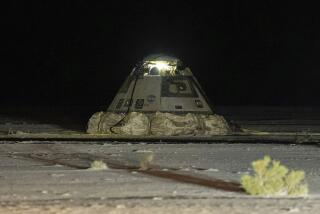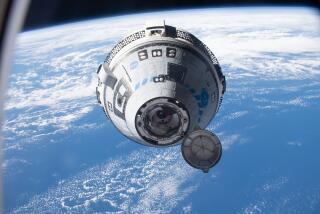Shuttle makes rare night landing
- Share via
The space shuttle Endeavour made an unusual nighttime landing Wednesday at Kennedy Space Center in Florida, ending a 16-day mission to the International Space Station highlighted by the installation of the first segment of the Japanese laboratory Kibo.
The return to Earth was delayed when clouds moved over central Florida late Wednesday afternoon, causing ground controllers to wave off the first landing attempt. The officials then asked shuttle commander Dominic Gorie if he would prefer to land at night through broken clouds or wait and try again today.
“We’re comfortable with the weather if you guys are,” Gorie said.
Ground controllers then gave the go-ahead for the first step in reentry, known as a de-orbit burn. That’s when braking engines are fired, causing the spacecraft to dip into the Earth’s atmosphere and begin slowing from its 17,000-mph orbital speed.
The approach to the landing site took Endeavour over the Pacific Ocean, crossing over the Yucatan peninsula and the Gulf of Mexico before heading north to Florida.
As Endeavour approached the landing site at Cape Canaveral, it could be seen streaking through the cloud bank, a specter of shining white that flickered in the darkness like a summer firefly.
“Welcome home,” a ground controller radioed.
“It was a super-rewarding mission,” Gorie replied as the shuttle coasted to a stop at 8:40 p.m.
Endeavour spent more time -- 12 days -- docked at the space station than any past shuttle mission. Astronauts performed a record five spacewalks to install the Japanese laboratory and to assemble a giant Canadian-built robot called Dextre, which will perform routine maintenance outside the station. The robot will allow space station crews to avoid going into space themselves, which is risky no matter how careful the spacewalkers are.
Altogether, the mission covered 6.5 million miles and made 250 orbits of the Earth.
With the latest construction, the space station is now 70% complete and weighs about 600,000 pounds.
The space shuttle journey, the second of the year, keeps the shuttle program on its ambitious schedule to complete six missions in 2008, as NASA hurries to finish construction work at the space station before the shuttle fleet is retired in 2010.
One of this year’s flights, set for August, is to be a repair mission to the ailing Hubble Space Telescope.
The delivery of the Kibo laboratory was a celebratory moment for Japan’s space agency, which announced that it at last felt like a full partner in the international project.
--
The Associated Press contributed to this report.
More to Read
Sign up for Essential California
The most important California stories and recommendations in your inbox every morning.
You may occasionally receive promotional content from the Los Angeles Times.










